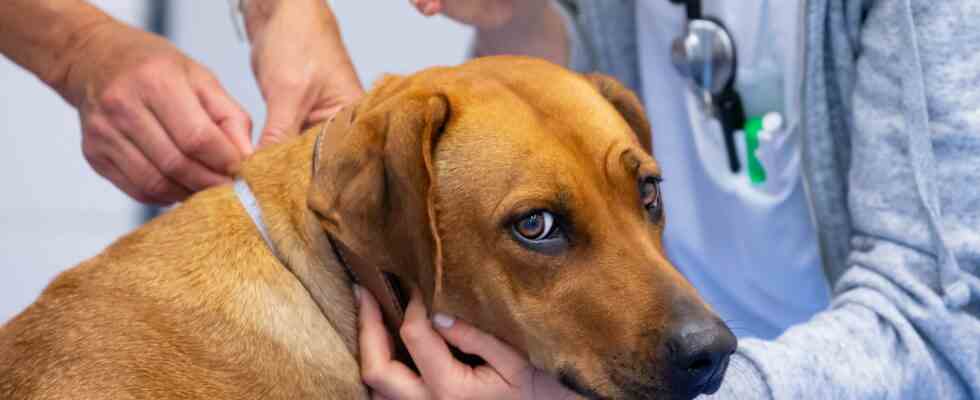Status: 22.11.2022 9:13 a.m
As of today, a new scale of fees applies to veterinarians. The price increases are clear. This affects farmers as well as pet owners. Are dogs and cats becoming luxuries?
Once a month, dairy farmer Jürgen Vogelgesang receives a bill from his veterinarian for the treatment of his animals. Depending on the state of health of his 250 cows, cattle and calves, that can be more than 1000 euros, as he says. These costs, from travel to treatment, are increasing significantly from today. Vogelgesang expects additional costs of around 40 percent. “The danger is that one or the other farmer will ask: Does it still make sense to call the vet?” He himself has no choice but to dig deeper into his pocket – even if little of his income sticks in the end.
The new scale of fees will also make it much more expensive for pet owners: The simplest examination at the vet now costs EUR 23.62 – previously it was EUR 8.98 for cats and EUR 13.47 for dogs. The prices for vaccinations for dogs and cats have almost doubled from EUR 5.77 to EUR 11.50.
Increased practice costs
Pets are now becoming even more of a luxury, says Valeska Eich, a veterinarian near Mainz. “Whereas keeping pets is an expensive affair anyway, if you do it in a species-appropriate manner.” However, the increase in costs is difficult for some pet owners, such as pensioners, to finance. At the same time, she hopes that the new scale of fees will make the profession of veterinarian more attractive, thereby improving care.
The Federal Chamber of Veterinarians also hopes so and defends the new fees. It is the first comprehensive revision in 23 years and now includes newer medical procedures such as computed tomography, according to a statement. The fee change is “overdue” and “extremely moderate”. “In addition, the practice costs, which amount to up to 75 percent of sales, have risen to a much greater extent than the inflation rate, and the developments in 2022, which have led to significant price increases in all areas of daily life, are not yet reflected in these prices once considered.”
Doctors can charge triple rate
However, the schedule of fees takes various factors into account, which means that veterinarians may charge three times the rate – instead of 23.62 euros for the examination with advice on dogs or cats, 70.86 euros would be due. These factors include the difficulty of the examination or the intervention, but also how much the animal to be treated cost: “The particularly high value of a patient requires additional effort for special care and liability insurance,” says an explanation from the Federal Veterinary Association .
The “local conditions” can also play a role in billing the fees, such as the amount of the rent or the market environment. If you follow these criteria, then it should be even more expensive for pet owners in big cities than in rural areas. And: the treatment of a pedigree dog could cost more than that of a mongrel. Last but not least, the specific behavior of the animal, for example if it becomes aggressive and disrupts the course of the practice, could have an impact. Ultimately, it is up to the vet’s discretion.
“Of course it’s different if you have to pay a doctor’s assistant in Munich or somewhere in the Allgäu,” says veterinarian Valeska Eich. In this respect, regional differences played a role in the settlement of the specific fees. She is also critical of the underlying factors, such as considering the value of an animal: “It doesn’t matter whether I’m treating a mongrel or a pedigree dog,” says Eich. Difficulty and time required for a measure are decisive. “I hope that there are no black sheep who take advantage of the scale of fees,” says Eich.
burden on animal shelters
In any case, the German Animal Welfare Association fears consequences, namely that pet owners with little money can no longer afford treatment. The Animal Welfare Association reports that there is a risk that the necessary examinations will not be carried out and that the number of animals given up in animal shelters will also increase. The association therefore proposes that the authorities temporarily issue vouchers that financially disadvantaged owners can redeem for examinations by the veterinarian.
According to the Tierschutzbund, animal shelters and animal protection associations also face significant additional costs that they would not be compensated for: “The animal shelters, which have agreed on flat-rate reimbursement regulations with the municipalities, are thus exposed to a not inconsiderable additional burden, although in this case they are only acting as service providers for the municipalities operate.” There was a failure to create cost compensation here.
Farmer Jürgen Vogelgesang is also worried about the financing of his farm with a view to the future. “In the long term, the question will arise: Does it still make sense to keep animals if the costs outweigh us?” says Vogelgesang. Saving on animal health is not an option for him. “In the worst case, animal husbandry would have to be stopped here.”

